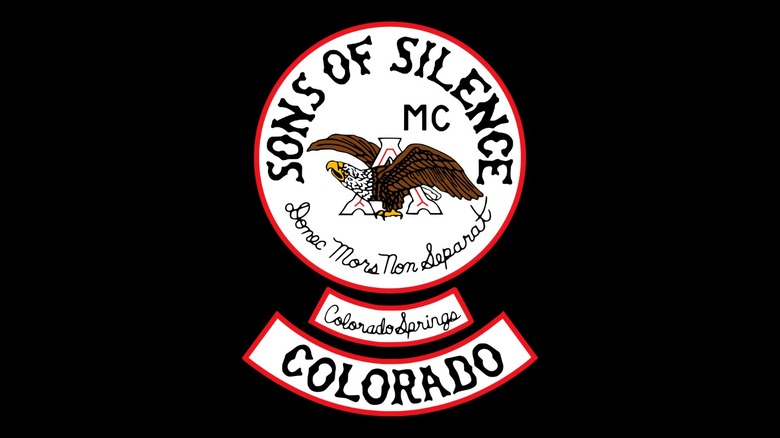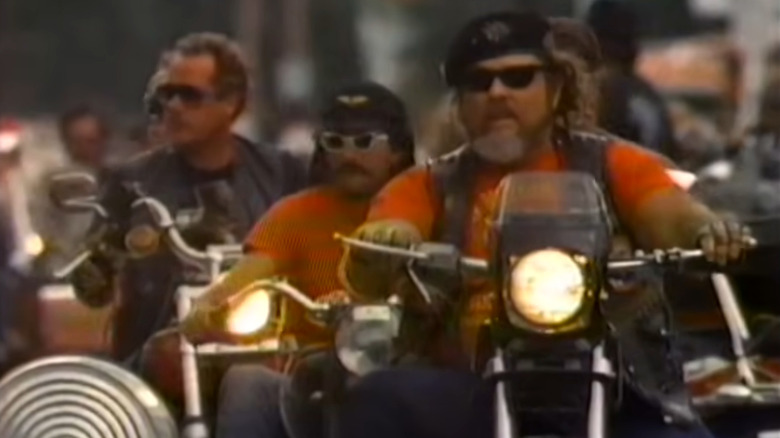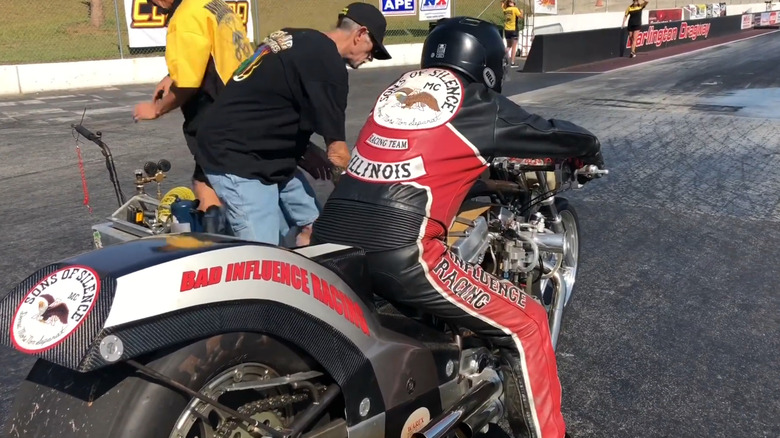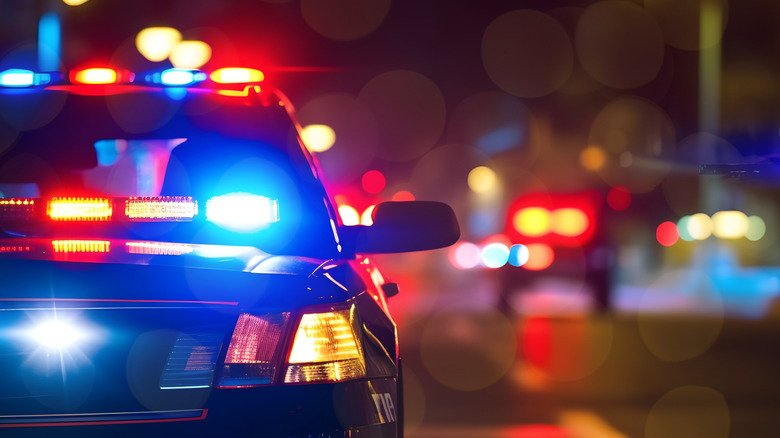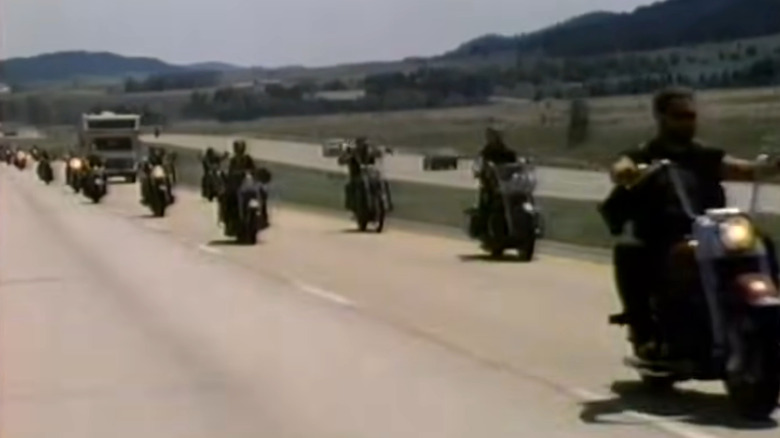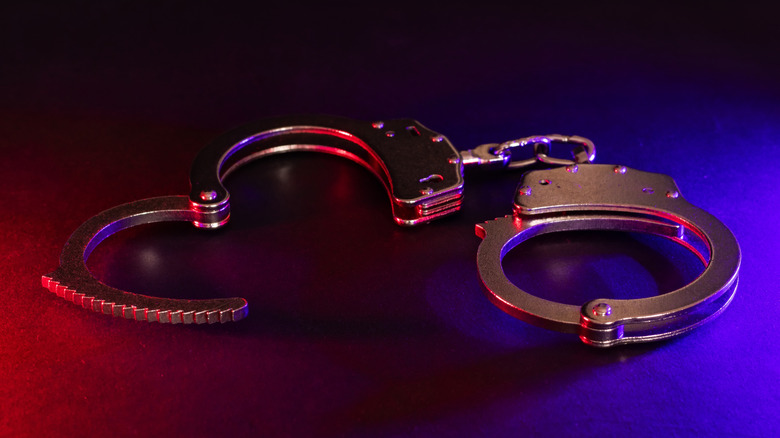A Brief History Of The Sons Of Silence Motorcycle Club
When people talk about outlaw motorcycle clubs in the U.S., they often speak of a "Big Four" that consists of the Hells Angels, Pagans, Outlaws, and Bandidos. Commonly accused of drug trafficking and other illegal activities (often falling under the purview of the RICO Act), the world of outlaw MCs is a complex one, with a seemingly endless list of smaller and lesser-known MCs working with and against the "Big Four."
One of these somewhat lesser-known MCs is the Sons of Silence. That said, the Sons of Silence, while not quite as notorious as the Big Four, carries enough weight to be mentioned alongside the "Big Four" in U.S. government literature. In fact, alongside the Mongols, the Sons of Silence could be said to make up a "Big Six" of outlaw MCs that have been on U.S. authorities' radar for the past few decades.
As with any allegedly criminal organization, there isn't exactly a wealth of information about the Sons of Silence and its history. This isn't some massive Japanese corporation, after all, and you're not going to get a clean-cut firsthand history of the MC conveniently laid out on the internet. Still, there's enough information out there to assemble a brief history of the Sons of Silence and give you insight into the club's place in the hierarchy of motorcycle clubs and so-called "outlaw gangs."
The Sons of Silence was founded in the 1960s
The story of the Sons of Silence starts in the late 1960s. By this point, outlaw MCs like the Hells Angels and Outlaws had been around for at least a couple of decades, which likely gave the Sons of Silence founder Bruce "The Dude" Richardson a template for the organization he would establish in Niwot, Colorado, in 1966. Richardson was a military veteran, having served in the U.S. Navy from 1958 to 1960.
Richardson's time at the helm of the MC was relatively short, at least when compared to his successor. Leonard Lloyd "JR" Reed took on the role of national president in 1977. Reed, a fellow Navy veteran, joined the Sons of Silence in 1975 and quickly climbed the ranks, first becoming president of the Colorado Springs chapter before taking control of the entire MC just a couple of years after being inducted. Reed would lead the Sons of Silence for at least the next 22 years and had a hand in establishing the Colorado Confederation of Clubs, a gathering of MCs in the state that exists to this day.
It's not clear who succeeded Reed as national president; the trail goes cold after him, with the Sons of Silence no longer publicly naming its leaders. Reed passed away in 2003. It's not clear what founder Richardson did after he handed leadership over to Reed, although it seems that he eventually left the club. That said, he didn't necessarily stay out of trouble; Richardson was handed a six-year jail sentence for his involvement in the 1984 kidnapping and extortion of a doctor. He passed away in 2013.
Expanding across the US
Founder Bruce Richardson's time at the helm of the Sons of Silence doesn't seem to be as celebrated as his successor's, but he played a crucial role in its expansion nonetheless. The Sons of Silence made its first moves outside its home state of Colorado in 1968 with the establishment of a chapter in Iowa. That was just the start: By the time of a 1991 U.S. Department of Justice report, the Sons of Silence had expanded significantly, boasting 17 chapters with footholds in Indiana, Illinois, Iowa, Kansas, Kentucky, Louisiana, and Minnesota (in alphabetical order).
The report also indicated that this expansion was helped by an alliance with the Hells Angels, specifically in Kentucky and Minnesota. While it's unclear if the Sons of Silence adopted rules similar to those the Hells Angels live by, we do at least know that the MC had a similar stipulation regarding motorcycles, with Indianapolis club president Howard "Duck" Miller revealing in 1982 that members, like those of other biker gangs, had to ride Harley-Davidsons.
The Sons of Silence seem to have expanded even further since 1991. A map on the club website indicates additional chapters in Arkansas, Florida, Idaho, Louisiana, Mississippi, Missouri, North Dakota, South Dakota, Utah, and Wyoming (again in alphabetical order). Recent estimates suggest that the MC has around 250 members, although, as with any allegedly criminal organization, there's likely no way to know for sure. There is one interesting quirk to its expansion worth mentioning, though: The MC has also gotten into racing, with representatives in drag racing and hill climbs.
Conflicts and run-ins with the law
As anyone even remotely familiar with the history of outlaw MCs like the Mongols will have guessed, the Sons of Silence's first few decades were far from squeaky clean. While there doesn't seem to have been a conflict on the scale of the one between the Mongols and the Hells Angels, the Sons of Silence's expansion was far from trouble-free. The MC butted heads with the Outlaws in Indiana in the 1970s and '80s as it sought to expand into the state, resulting in injuries and deaths on both sides.
The Sons of Silence didn't just come into conflict with other MCs; its members have also fallen afoul of the law over the years. Incidents include a 1972 brawl in Colorado Springs, where six Sons of Silence members — including then-president Bruce Richardson — were jailed for assault with a deadly weapon. A newspaper report of the time claims that some of the six were also suspected of involvement in conspiracies to harm police officers and their families earlier that same year.
The FBI started investigating the Colorado chapter in 1981 on suspicion of distributing illicit drugs. As a result, authorities arrested a few Sons of Silence drug couriers in 1983, which led to the 1985 conviction of six MC members. Other federal investigations involving the MC included 1986's Operation One Percenter, which focused on major one percenter motorcycle clubs and several smaller MCs, with 53 bikers arrested and significant amounts of illegal drugs and firearms seized. Similarly, a 1999 ATF investigation led to the arrest of 39 club members, including president Leonard Reed. Guns, cash, drugs, and bikes were also seized.
Going international
The Sons of Silence were a strictly American affair for most of their early decades, but that changed in 1998 when the MC established its first international chapter in Munich, Germany. The MC spread its wings even further in Germany a few short years later, with three more chapters — in Freising, Gangkofen, and the greater Nürmberg area — joining the Sons of Silence in 2001, before a South Central chapter was opened in 2002.
Unlike some of the Hells Angels' international chapters, the German Sons of Silence don't seem to have garnered much negative press, though that doesn't necessarily mean the club is free of criminal elements. Either way, the Sons of Silence continued its expansion into the heart of the EU over the next few decades and is still growing at quite a pace; the two most recent additions were chapters in the German municipalities of Pfarrkirchen and Steinach, in 2015 and 2025, respectively.
The Sons of Silence's operations in Germany have thus far been limited to the central and southern areas, including the state of Bavaria, and it remains to be seen whether it will ever expand northward. It may be able to count on the support of a support club if it ever does so, though. Like the American Sons of Silence, which has several support clubs, the Sons of Silence Germany has the backing of the Silent Crew MC, founded in October 2011.
The Sons of Silence hasn't stayed out of trouble
Like many of their one-percenter brethren, the members of the Sons of Silence are still kicking up a storm on their Harleys and have continued to run afoul of the law in the process. In 2011, for example, 12 Sons of Silence members were indicted for their part in a methamphetamine distribution ring in Terre Haute, Indiana. One of the 12 was eventually sentenced to life imprisonment for his involvement, as well as for organizing the kidnapping of a person who had allegedly stolen $5,000 from the MC's drug operations.
In 2014, the local president of the Kansas City Sons of Silence chapter was charged with the interstate transportation of a minor for purposes of prostitution. The Sons of Silence member, along with an accomplice, pleaded guilty; they were sentenced to 10 years and 16 months in prison, respectively, the former without parole.
The late 2010s and 2020s have continued to see Sons of Silence members and associates spend time behind bars. In 2020, an enforcer for the northern Iowa chapter was sentenced to 10 months in prison for possessing a firearm as a felon. A few years later, the United States Attorney's Office handed down a 10-year prison sentence to a higher-up of the Colorado Springs chapter for felony firearm possession and drug-related offenses, namely possessing methamphetamine with the intent to distribute it. Lives have been lost, too: a North Dakota Sons of Silence enforcer was found guilty of murder in 2019 and sentenced to life imprisonment. There's a lot more if you care to dig, but these snippets should show you that the Sons of Silence isn't necessarily the nicest organization around.
